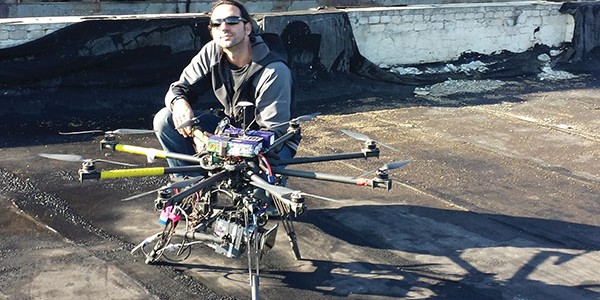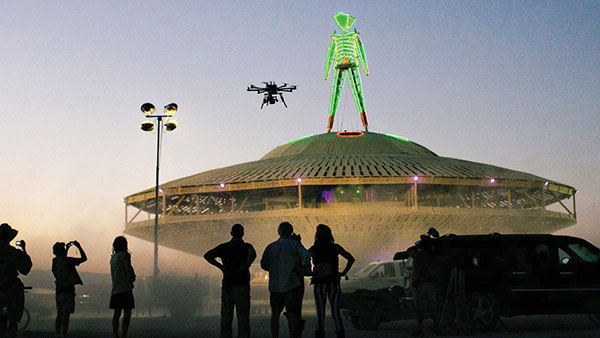When Sylvester Stallone’s movie The Expendables 3 opens this summer, audiences will be wowed by an opening sequence that includes a speeding train, a helicopter and explosions, all shot from a bird’s-eye view that will make viewers feel like they’re a part of the action, courtesy of Ziv Marom’s multirotor.
“We flew right next to a train and helicopter,” says Marom. “We shot everything from chasing tanks to explosions to flying over buildings and motorcycle jumps. We can also do shots that a real helicopter can’t do. We can do lower altitudes.” Another bonus: before the advent of multirotors, movie studios had to use man-carrying planes and helicopters to get the same footage, often putting the pilot and camera person in danger. Using a small multirotor greatly reduces those risks, as well as brings production costs down. Their compact size is more versatile, too; for one shot in The Expendables 3, a multirotor with a camera flew outside a building’s window to catch the action, then flew back inside. We had a chance to talk to Marom, owner/operator of ZM Interactive, about his work around the world using different cameras and products for applications that range from aerial cinematography to security to rescue missions.
RotorDrone: How did you get involved in multirotors?
Ziv Marom: I was always into robotic technology, even when I was back in Israel and at the Israel Defense Forces and as a hobbyist when I was a kid. Working in motion graphics, editing, and animation, I was looking for low-budget solutions to get low-altitude shots that you can’t get with real helicopters or heavy crane equipment. I built my first multirotor for filming about six and a half years ago. I had to translate German documents to learn the electronics and programing; there were no tutorials or any documentation in English. That was a challenging experience.
Above: Ziv Marom with Dolph Lundgren between shooting on the set of The Expendables 3
Are your flights completely pre-planned or improvised while you’re in the air?
It depends on the application. The shot is discussed, so we know what we’re looking for and we have a flight path in mind. For film I always fly manual to have a better feel and control of the SUAV. Flying for film is very different and most of the time harder than any other application. The motion must to be super steady and smooth, especially with high-res film cameras. Keeping the speed and altitude in turns and when climbing or decanting is crucial. Most of the time, flying for film is a collaboration between the two or even three operators: the pilot, the camera operator and sometime a third person to pull focus.When flying for film, I sometimes change the [aircraft] setup, depending on the camera and lens, weather, and the scene, also different propeller sizes, motors, and different frame configurations.For other applications like rescue and especially security, most of the work is pre-programmed auto-pilot, flying a path and monitoring the flight with the option to go manual or change the path in flight.
Below: These are some of the screen shots of the aerials my team did from the original The Expendables 3 trailer.
We have different platforms for different payloads, flight time, weather and missions. For film, we use hexa, octo, X8, X12 or even X16, depending on the camera and flight situation. The largest payload for film will probably be two Red Epic/Dragons or real film cameras equipped with heavy lenses, filters, follow-focus and more. The cameras will change depending on the scene or shot. Most of the time we fly cinema cameras like Red Epic/Dragon or similar size. For that, we will use the X8, flat octocopter or single rotor for faster flights. We’ve never had to fly longer than 10 minutes for a scene, so the setup is built for a heavy payload with short flight times where the focus is on the smoothness of the flight and camera gimbal.
Above: Flying the high- end Red Epic camera at BurningMan over the Man before the evening fire.
Security platforms will be a lot smaller most of the time, smaller cameras, day or night vision, with longer flight time. For rescue missions, we have about 20 different platforms, sometime flying together with different sensors for finding survivors or delivery of different payloads. These platforms can fly up to two hours, depending on payload, weather and flight.
Above: Ziv tests another new drone platform. For more information on the drone platforms, check out flyingPOV.com
Was shooting The Expendables 3 a challenge?
My main passion is film, so shooting this movie was my most exciting and challenging project so far. Our team, which includes myself, Christopher Marino, Johnny Beavers and Andy Peacock, spent two months in Bulgaria, flying in different locations, over the ocean, mountains, rivers, inside buildings, achieving challenging scenes. I was flying heavy film cameras over firing tanks, motorcycles jumping, flying through smoke and fire and more. It was amazing!
For more info about ZM Interactive, go to Zminteractive.com
By team rotordrone Photos courtesy of ZM Interactive


























